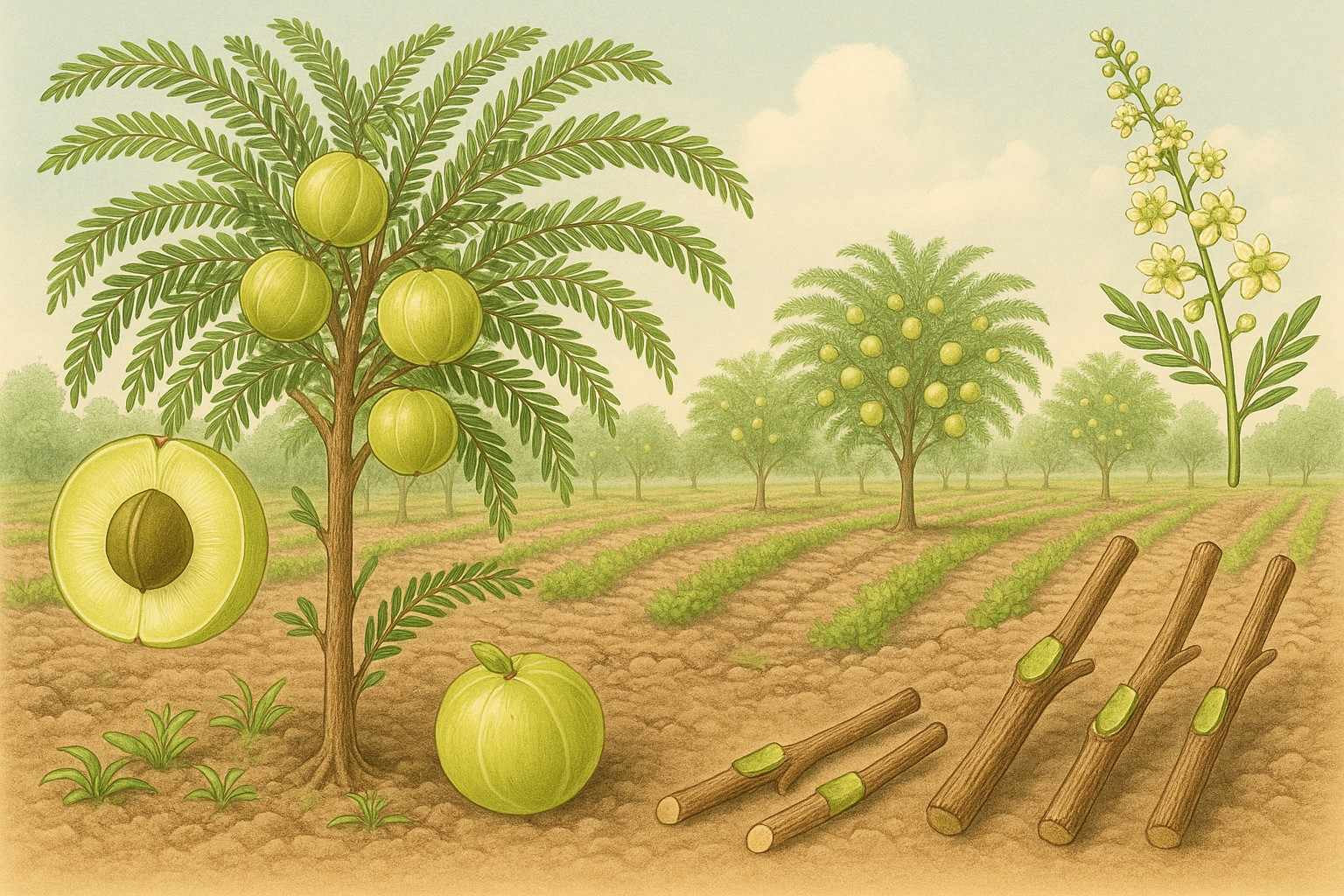Botanical Name – Emblica officinalis L.
Family – Euphorbiaceae
Chromosome No. – 2n =28 (tetraploid), 2n=14 x= 98
Other Name – Indian Gooseberry, Amla, Fruit of 21st Century, Malacca tree
Inflorescence – Racemose (Axillary cyme)
Fruit – Capsule
Propagation – Patch and Modified ring budding
Training system – Modified central leader system
Maturity indices – Change in seed colour from creamy white to brown-black
Edible part – Pericarp (Mesocarp and endocarp)
Origin and Distribution
Aonla is said to be indigenous to tropical South-Eastern Asia. It is also reported to be the native of India, Ceylon, Jalaysia and China. The data on area under Aonla cultivation are not available. Although, it. is found growing in different states throughout tropical India even up to elevation of 1500 m in South India. It thrives well through tropical India, however, commercial orcharding can be seen in U.P; and-Gujrat the main Aonla growing areas of U.P; like Faizabad Pratapgarh, Allahabad and Varanasi.
Soil & Climate
This is a fruit of sub – tropical region but its cultivation in tropical climate is quite successful. The trees is not much affected either by hot wind or frost. The mature trees can tolerate freezing temperature as well as a temperature as high as 460 C. Soon after the fruit set in spring, the fruits remain dormant through summer without any growth, makes it highly suitable fruit crop for arid region. aonla is not very exacting in its soil requirement and grows well in sandy loam to clay soils in India. It has a great tolerance to salinity and cultivated in P.H. range of 6.0 to 9.0 or 6.5-9.5 very successful. However, production shall be highly benefited in deep and fertile soils.
Planting
Grafts (wedge, approach, softwood), buddings (patch budding during June-Sep.) or seedling of Aonla are best planted in the beginning of monsoon in the months of June to July. Young plants should be planted at 8×8m or 6×6 m spacing is recommended. In areas with irrigation facilities planting can also be done in spring (February to March). Prior to plantings the field should be deeply ploughed, harrowed, leveled and marked appropriately. The pits 1×1×1 m size are made well in summer (May-June), kept open for about a fortnight fill each pit 10- 15kg FYM are mixed with surface soil and filled. After first shower the plants are planted in the center of these pits and staked properly. 180 plants/hac is accommodated, cross pollinated crop (NA-7 as filler to serve as pollination). Ideal Time of Planting is July- October.
Varieties Cultivated
Balwant (NA-10)
Fruits are medium to large size, round with little warty skins weighing about 40g. Fruits are attractive with light green having a pinkish tinge. Five to 6 six-year-old tree yields about 42 kg/tree. Vitamin ‘C’ content is about 528 mg/100g pulp.
Amrit (NA-9)
Seedling selection from banarasi.
Neelam (NA-7)
A seedling selection of Franchis, it is precocious, prolific and regular bearer (9.7 female flowers/branchlet). This is an ideal variety for the preparation of products and has a great promise.
Amrit (NA-6)
A seedling selection from Chakaiya, it is prolific and heavy bearer (10.8 female, flowers/branchlet). It is ideal for preserve and candy, owing to low fiber content.
Kanchan (NA-5)
Chance seedling selection from banarasi, early maturing Qct – Nov.) ideal for candy for juice.
Kanchan (NA-4)
Fruits are light yellowish green, medium sized fruits (30–32g). Vitamin ‘C’ content is about 711mg/100g pulp. Five to 6-year-old tree yields about 35–38kg/tree. Suitable variety of pickle purpose.
Chakaiya
Fruits are greenish white colour, medium size (33–35g). Fiber content is high, Vitamin ‘C’ is about 789mg/100g pulp. A five-year-old tree bears yields about 30kg/tree.
Francis
It is known as Hathi jhool originated from UP. The variety is seedling selection. Fruit size is large, oval, roundish, light green & slightly fibrous. It is prolific bearer but has serious incidence of fruit necrosis.
BSR-1
Variety is released from Tamil Nadu Agricultural University. Fruits are pinkish coloured and small sized (12–14g). Vitamin ‘C’ content is about 650mg/100g pulp. A five-year-old tree yield about 40–45kg/tree. Suitable variety for pharmaceutical use.
Goma Aishwarya
Early maturing selection from NA-7 released from CIAH, Bikaner.
Lakshmi-52
Selection made at private orchard in U.P.
Training and Pruning:
As the branches of Aonla trees often break off carrying heavy crop lead due to brittle nature of, wood the plant should be trained a strong-frame for which the tree should be trained to single stem up to the height of 0.75 m from the ground. The plant should trained to modified leader system. The frame work should be developed by encouraging the growth of 4 to 6 well-spaced branches all around the trunk.
The pruning of the bearing plants can be done after the termination of the crop each year. While pruning, dead, diseased, broken, weak, crossing branches and suckers appearing, from root stock should be removed. Tree is trained by central leader system. In March-April training should be done.
Intercropping
During first three years, intercrops such as groundnut, horse gram, pulses and other leguminous crops or medicinal and aromatic crops can be grown.
Mulching
Paddy straw, sugarcane trash and farmyard manure are used for mulching.
Flowering, fruit set and yield per acre
Flowering occurs on new shoots in the month of January–February. Indeterminate shoots are produced on main shoots, later on, flowers are borne on new definite branches. Male flowers are produced first at the bottom and later female flowers at the tips of these branches. Fruit set occurs by cross pollination and later fruits enter into a prolonged dormancy for up to four months (March–June), during this period tree basins should not be disturbed. By the commencement of monsoon, dormancy is released and fruits start developing rapidly and will be ready for harvest in October. A fully grown tree of about 10-year-old yields up to 100 to 200 kg/tree.
Manuring and Fertilization
Regular orcharding of Aonla is a rare phenomenon, therefore, nutritionist hardly practiced. However, beneficial effect of nitrogen, phosphorus potash, zinc, copper, manganese and boron have been recorded. Nitrogen increased vegetative growth and female flowers, while P2O5 increased sex ratio, initial set, fruit retention and yield, TSS and vitamin C content of the fruit. Potassic fertilizer increased the fruit retention and quality. The young plant should be given 15-20 kg FYM and the matured tree 30 to 40 kg per year during Sept-Oct in addition, application of 30gm. N for each year age of the plant up to 10 years and afterwards-1 kg N, 1 kg Pand 1 to 1.5 kg K per plant per year should be provided, in two equal doses .to mature bearing free tree once during and again during April-May after setting of fruit. The plants need to be irrigated after fertilizer application. Spray of 0.6 per cent borax thrice in the month of September and October at about 10-15 days interval to control fruit necrosis which develops due to deficiency of boron.
Irrigation
Aonla trees are hardy; and stand very well against drought. Therefore, hardly any irrigation is practiced. The young plants require watering during summer, months at fortnightly intervals till they have fully established. The crop shall be benefited by giving 2-3 irrigations at the time of bloom and set. Irrigation during Oct. to Dec, at 20 days interval helps, in better development of fruits. During summer, when the fruit is dormant, there may not be any benefit to irrigate trees.
Fruiting
Flowering takes place on determinate shoots appearing in spring season. There is no self-incompatibility in Aonla and the cause of poor fruit set (12 – 18%) may be due to a high percentage of staminate flowers. Flower and fruit drop in Aonla is divided in three stages. The ‘first drop’ is the highest as 70% of the flowers drop off within three weeks of flowering due to unfertilized ovaries and degenerated ovules. The ‘second drop’ occurs from June to September, consists of drop of young fruit lets at the time of dormancy break may be due to lack of pollination and fertilization. The ‘third drop’ is spread over a period of rapid growth from August to October may be due to lack of auxins i.e., embryological and physiological factors.
Harvesting time
A vegetatively propagated tree starts fruiting commercial crop after 6 – 8 years of planting, while seedling trees may take 10 to 12 years to begin bearing. Productive life of trees is estimated to be 50 to 60 years under good management. Generally, Aonla fruits are ready for harvest in November / December. Their maturity can be judged either by the change of seed colour from creamy white to black or by the development of translucence exocarp. The fruits are light green at first when they mature the colour becomes dull, greenish yellow or rarely brick red. Maximum Vitamin C content is observed in mature fruits while immature fruits are acrid and low in Vitamin ‘C’ content and minerals.
Harvesting – all full maturity
- Specific gravity – 1.07-1.10
- TSS/acid ratio – 5 to 6
- Green to shining whitish green fruit
- Seed colour – creamy white to brown
Yield:
The production varies from cultivar to cultivar. A full grown grafted Aonla with good bearing habit yields from 100 to 300 kg fruits per tree.
Plant Protection Measures
Insect Pests
Leaf rolling caterpillar, shoot gall maker, mealy bug and pomegranate butterfly are major constraints in aonla production. The pests can be managed through clean cultivation, avoiding the over crowing of branches, spraying with malathion or monocrotophos or endosulphon depending on the type of pest infestation.
Diseases
The Crop is suspect to diseases like ring rust, fruit rot, leaf rot etc. Timely treatment and control measured are needed.
- Aonla Rust ( Ravenelia Emblicae)
Disorders:
Necrosis, a physiological disorder has been observed in aonla fruits. This particular disorder has been observed mostly in case of Banarasi and Francis varieties.
POST HARVEST MANAGEMENT
Grading
The fruits are harvested manually and sorted according to their size. Fruits are graded into three types on the basis of their size. The large sized fruits are mostly used for preserve and candy; small sized for preparing the blemished fruits for powder and shampoo making.
Storage
Fruits can be stored for a period of 6-9 days under ordinary conditions.
- Chakiya and Francis can be stored for 9 days.
- Banarasi can be stored for 6 days.
Packing
Bamboo baskets are mostly used for carrying the produce from farm to local market.
Transportation
Road transport by trucks/lorries is the most convenient mode of transport due to easy approach from orchards to the market.
Marketing
Most of the growers sell their produce either through trade agents at village level or commission agents at the market.
– Dr. Alok Kumar, Assistant Professor
Department of Horticulture, Madhav University

